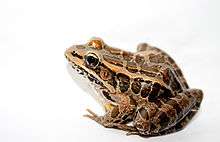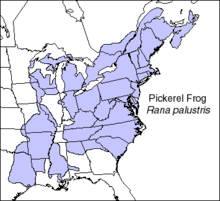Pickerel frog
The pickerel frog (Lithobates palustris, formerly Rana palustris) is a small North American frog,[1][2] characterized by the appearance of seemingly "hand-drawn" squares on its dorsal surface.
| Pickerel frog | |
|---|---|
 | |
| Scientific classification | |
| Kingdom: | Animalia |
| Phylum: | Chordata |
| Class: | Amphibia |
| Order: | Anura |
| Family: | Ranidae |
| Genus: | Lithobates |
| Species: | L. palustris |
| Binomial name | |
| Lithobates palustris (LeConte, 1825) | |
 | |
| Pickerel frog range | |
| Synonyms | |
|
Rana palustris LeConte, 1825 | |
Distinguishing features
The pickerel frog is a medium sized gray or tan frog marked with seven to twenty-one irregular rectangular dark brown spots which are oriented in two columns down its back.[3] The distinctive rectangular spots of the pickerel frog may blend together to form a long rectangle along the back. All leopard frogs have circular spots. In addition, pickerel frogs have prominent dorsolateral ridges that are unbroken. Another important distinguishing mark is the orange or yellow flash pattern found on the inner surface of the hind legs of pickerel frogs. The frog must be picked up to examine this, as the legs cover the coloration otherwise. The plains leopard frog (Lithobates blairi) exhibits this coloration as well, but the dorsolateral ridges are interrupted and inset medially in that species. The front toes of pickerel frogs are not webbed, a morphological characteristic for some frogs of the genus Rana and some frogs of the genus Lithobates. This allows pickerel frogs to be fit for terrestrial life.
Sexual dimorphism
Pickerel frogs display sexual dimorphism; the females are typically larger and darker in color than the males.[4] During the summer and breeding season males can be recognized by their swollen thumbs. Males also have internal vocal sacs located between the tympanum and the foreleg. In general, secondary sexual characteristic are not typically evident outside of the breeding season; therefore, pickerel frogs can be rather difficult to sex.[5]
Range
The pickerel frog ranges in the west from much of Wisconsin, southeast Minnesota, eastern Iowa, through Missouri and down to eastern Texas. To the east they extend through northern Louisiana, most of Mississippi, northern Alabama, Georgia, and South Carolina to the coast. Their northern range extends into Canada in the southern reaches of Ontario, Quebec, New Brunswick, and Nova Scotia. The range is spotty through the midwestern states and a field guide should be obtained for the specifics on ranges in a particular area.
Habitat
Pickerel frogs have varied habitats, the northern specimen prefers to live near cold, clear water. They prefer rocky ravines, bogs and meadow streams, but can be found around lakes and rivers that are heavily wooded. The southern specimen prefer warmer waters, like those of the Coastal Plain and floodplain swamps. They are seen most often along the edges of streams, lakes, rivers, and even flooded ditches. During the winter months they will hibernate under the silt and debris in their aquatic environments; they are usually only active from April to October.[6]
Breeding habitat
Pickerel frogs prefer cool clear water. They breed in both temporary ponds and permanent ponds but appear to favor ponds with long to permanent hydroperiods. In Rhode Island specifically, pickerel frog tadpoles and eggmasses were found in permanent manmade rural ponds, farm ponds, and urban ponds surrounded by roads; all of the mentioned habitats were well-vegetated.[7]
Reproduction
Pickerel frogs typically emerge from hibernation around mid April with the majority of the frogs arriving at breeding ponds by early May. At the ponds, pickerel frogs are usually observed in large groups in the water.[8] Mating behavior is not much different from other ranids. The males initiate breeding by emitting their low pitched call; this call is usually so low pitched that it is often not heard during calling surveys.[9] Males are known to call while submerged. Frogs reproduce using a method called Amplexus, a type of external fertilization; sometimes it will last more than a day or two, even after the female has deposited the eggs.[4]
Egg mass
Egg masses are typically laid in well-vegetated areas and are often difficult to locate. The masses superficially resemble those of wood frogs but at close inspection one can usually distinguish between the two. Pickerel frog egg masses are spherical and about the same size of a wood frog egg mass roughly 5–10 cm in diameter; however, pickerel frog egg masses contain more eggs, about 2000-3000 eggs.[4] Pickerel frog eggs are multicolored, they are dark brown on top and cream colored on the bottom. The egg masses adhere to woody or herbaceous vegetation, varying in depth from a few centimeters below the surface to 4 feet deep.[5] Like most amphibious eggs development is temperature dependent, but pickerel frog eggs usually hatch in 11–21 days.[10]
Larvae
The tadpole stage lasts roughly 3 months. Small pickerel tadpoles are yellowish to yellowish brown in color; as they grow their color changes to an olive green, which eventually changes to gray brown on top and cream colored underneath. Larger tadpole are often mistaken as green frogs. There are a few characteristics to aid in distinguishing between pickerel and green tadpoles. The nose of the pickerel frog tadpole is more pointed, the eyes are closer together, and the nostrils are closer to the edge of the nose.[11]
Metamorphs
This is the stage where frogs have all four limbs and are able to walk on land, but still have their tails. They are not quite juvenile frogs. Metamorphs are roughly 2.6 cm long, but they are nearly as agile as the adult and juvenile when they emerge from the ponds. They are often mistaken for the closely related leopard frog.
Diet
The pickerel frog's diet consists of ants, spiders, various bugs, beetles, sawfly larvae, and other invertebrates. In order to catch their prey pickerel frogs will often search grassy areas next to bodies of water.[3]
Defense mechanism
In case of attack, pickerel frogs have an excellent defense mechanism: they emit skin secretions which are irritating to people and toxic to some predators; making the pickerel frog the only poisonous frog native to the United States.[12] Due to its poison, most mammals, birds, snakes and other frogs will leave the pickerel frog alone. The skin secretions of a stressed pickerel frog are known to be toxic to other frogs, as many a novice frog catcher has found when he finds only the pickerel frog still alive in his bucket. These secretions can also be moderately irritating if they come in contact with the eyes, mucous membranes, or broken skin.
Predators
The pickerel frog's poisonous secretions cannot stop all creatures; green frogs, bull frogs, northern water snakes, eastern ribbon snakes, and common garter snakes are their usual predators.[13] When threatened, pickerel frogs will jump into the water and dive to the bottom to escape predators like birds and snakes.
References
- Hammerson, Geoffrey. (2004). "Lithobates palustris". IUCN Red List of Threatened Species. 2004. Retrieved 29 August 2014.CS1 maint: ref=harv (link)
- Frost, Darrel R. (2014). "Lithobates palustris (LeConte, 1825)". Amphibian Species of the World: an Online Reference. Version 6.0. American Museum of Natural History. Retrieved 29 August 2014.
- Who is the Pickerel Frog. http://people.wcsu.edu/
- Mairs, D.F. (1999). "Pickerel Frog". pp. 98-100. In: Hunter, M.L., A.J.K. Calhoun, and M. McCollough, editors. Maine Amphibians and Reptiles. The University of Maine Press. Orono, Maine.
- Wright, A.H., and A.A. Wright. (1949). Handbook of Frogs and Toads of the United States and Canada. Comstock Publishing Company, Inc. Ithaca, New York.
- Zweifel, Richard G. (editor). (1971). Catalogue of American Amphibians and Reptiles. 1971. Society for the Study of Amphibians and Reptiles. 117.1. This catalogue is an excellent source, containing the detailed taxonomy of Rana palustris as well as an extensive bibliography.
- Paton, P.W.C., and S. Egan. (2001). Effects of Roads on Amphibian Community Structure at Breeding Ponds in Rhode Island. Unpublished Final Report to the Transportation Environmental Research PROGRAM (TERP) Federal Highway Administration.
- Green, N.B., and T.K. Pauley. (1987). Amphibians and Reptiles in West Virginia. University of Pittsburgh Press. Pittsburgh, Pennsylvania.
- Paton, P.W.C., and W.B. Crouch III. In press. Using Phenology of Pond-Breeding Amphibians to Develop Conservation Strategies. Conservation Biology.
- Degraaf, R.M., and D.D. Rudis. (1983). Amphibians and Reptiles of New England, Habitats and Natural History. University of Massachusetts Press. Amherst, Massachusetts.
- Dickerson, M.C. (1906). The Frog Book, North American Toads and Frogs with a Study of the Habits and Life Histories of those of the Northeastern States. Doubleday, Page and Company. New York.
- Conant, Roger, and Joseph T. Collins. (1991). A Field Guide to Reptiles and Amphibians of Eastern and Central North America, Third Edition. Houghton Mifflin Company. Boston. pp. 130-134. This guide discusses identification, distribution, lifestyle and ecology, and the conservation status of Rana palustris.
- Pickerel Frog. "Archived copy". Archived from the original on 2014-12-27. Retrieved 2014-12-15.CS1 maint: archived copy as title (link)
Further reading
- Arnold, K. (2000). Lithobates palustris Pickerel Frog (On-line), Animal Diversity Web. Accessed August 29, 2014.
- Hillis, David M. (2007). "Constraints in naming parts of the Tree of Life" (PDF). Molecular Phylogenetics and Evolution. 42 (2): 331–338. doi:10.1016/j.ympev.2006.08.001. PMID 16997582.
- Hillis, David M. & Thomas P. Wilcox (2005). "Phylogeny of the New World true frogs (Rana)" (PDF). Molecular Phylogenetics and Evolution. 34 (2): 299–314. doi:10.1016/j.ympev.2004.10.007. PMID 15619443. Archived from the original (PDF) on 2008-05-28.
- Leconte, John. (1825). "Remarks on the American species of the genera Hyla and Rana ". Ann. Lyceum. Nat. Hist. New-York [sic] 1: 278-282. (Rana palustris, new species, p. 282).
- Redmer, M. & K.S. Mierzwa (1994). "A review of the distribution and zoogeography of the pickerel frog, Rana palustris, in northern Illinois". Bulletin of the Chicago Herpetological Society. 29: 21–30.
- Pauly, Greg B.; David M. Hillis & David Charles Cannatella (2009). "Taxonomic freedom and the role of official lists of species names" (PDF). Herpetologica. 65 (2): 115–128. doi:10.1655/08-031R1.1. Archived from the original (PDF) on 2011-07-26.CS1 maint: multiple names: authors list (link)
External links
| Wikimedia Commons has media related to Rana palustris. |
| Wikispecies has information related to Rana palustris |
- Comparison of pickerel frog vs. leopard frog species
- Species information from the USGS.
- Very detailed biology of the pickerel frog on The Frogs & Toads of Georgia.
- Pickerel Frog, Natural Resources Canada
